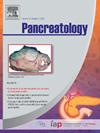Ca2+ signaling of pancreatic acinar cells in malignant hyperthermia susceptibility
IF 2.7
2区 医学
Q2 GASTROENTEROLOGY & HEPATOLOGY
引用次数: 0
Abstract
Background
Malignant hyperthermia susceptibility (MHS) and acute pancreatitis (AP) share a common cellular pathomechanism that is Ca2+-overload of the muscle fiber and the pancreatic acinar cell (PAC). In the muscle, gain-of-function mutations of the ryanodine receptor (RyR1) make the Ca2+-release mechanism hypersensitive to certain ligands, including Ca2+, volatile anaesthetics and succinylcholine, creating a medical emergency when the patient is exposed to these drugs. As RyR1 was shown to contribute to Ca2+-overload in PAC, we presumed that pancreata of MHS individuals are more prone to AP. Accordingly, a recent case study reported coincidence of MHS with recurrent AP, indicating a pathological link between the two diseases.
Methods
We tested if MHS poses a risk for AP in mice carrying the Y522S MHS mutation.
Fluorescent Ca2+ imaging was performed in PACs. Conventional histopathological analysis and plazma amylase measurement was performed using a cerulein-induced pancreatitis mouse model.
Results
The intracellular Ca2+-signals of PACs from MHS mice were slightly bigger then in wild type when stimulated with 0.2 and 2 μM carbachol (cch) or with 1 and 5 mM bile acid (taurocholic acid). Store-operated-Ca2+-entry was also higher in PACs from MHS mice. Nevertheless, histopathological analysis and plasma amylase levels did not indicate more severe AP in MHS.
Conclusions
These results suggest that the Y522S RyR1 mutation alter the Ca2+-homeostasis in PACs, but not as much as to cause or aggravate AP.
胰腺尖顶细胞的 Ca2+ 信号在恶性高热中的易感性
背景:恶性高热惊厥(MHS)和急性胰腺炎(AP)有一个共同的细胞病理机制,即肌纤维和胰腺尖细胞(PAC)的Ca2+超载。在肌肉中,雷诺丁受体(RyR1)的功能增益突变使 Ca2+ 释放机制对某些配体(包括 Ca2+、挥发性麻醉剂和琥珀胆碱)过敏,当患者接触到这些药物时就会出现医疗紧急情况。由于 RyR1 被证明会导致 PAC 中 Ca2+ 过载,我们推测 MHS 患者的胰腺更容易发生 AP。因此,最近的一项病例研究报告称,MHS 与复发性 AP 相吻合,表明这两种疾病之间存在病理联系:我们测试了MHS是否会导致携带Y522S MHS突变的小鼠出现AP。我们在 PAC 中进行了 Ca2+ 荧光成像。使用脑啡肽诱导的胰腺炎小鼠模型进行了常规组织病理学分析和淀粉酶测定:结果:在 0.2 和 2 μM 卡巴胆碱(cch)或 1 和 5 mM 胆汁酸(牛胆酸)刺激下,MHS 小鼠 PAC 细胞内 Ca2+ 信号比野生型略大。在 MHS 小鼠的 PAC 中,贮存-操作-Ca2+-入口也更高。尽管如此,组织病理学分析和血浆淀粉酶水平并未表明 MHS 的 AP 更为严重:这些结果表明,Y522S RyR1 突变改变了 PAC 的 Ca2+ 稳态,但并没有导致或加重 AP。
本文章由计算机程序翻译,如有差异,请以英文原文为准。
求助全文
约1分钟内获得全文
求助全文
来源期刊

Pancreatology
医学-胃肠肝病学
CiteScore
7.20
自引率
5.60%
发文量
194
审稿时长
44 days
期刊介绍:
Pancreatology is the official journal of the International Association of Pancreatology (IAP), the European Pancreatic Club (EPC) and several national societies and study groups around the world. Dedicated to the understanding and treatment of exocrine as well as endocrine pancreatic disease, this multidisciplinary periodical publishes original basic, translational and clinical pancreatic research from a range of fields including gastroenterology, oncology, surgery, pharmacology, cellular and molecular biology as well as endocrinology, immunology and epidemiology. Readers can expect to gain new insights into pancreatic physiology and into the pathogenesis, diagnosis, therapeutic approaches and prognosis of pancreatic diseases. The journal features original articles, case reports, consensus guidelines and topical, cutting edge reviews, thus representing a source of valuable, novel information for clinical and basic researchers alike.
 求助内容:
求助内容: 应助结果提醒方式:
应助结果提醒方式:


